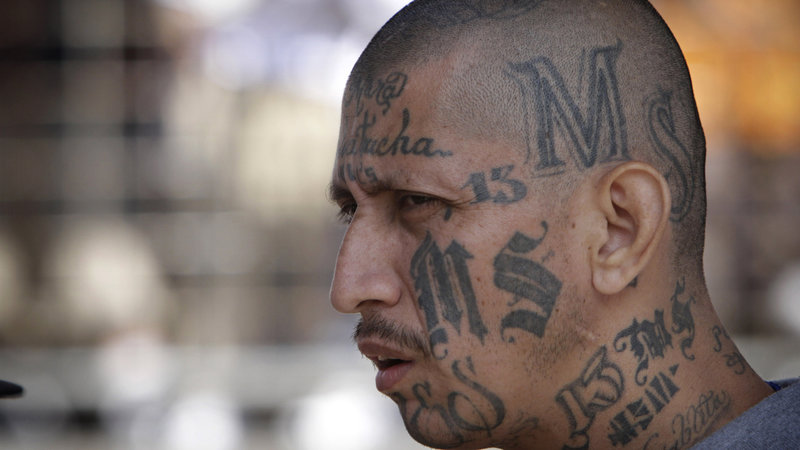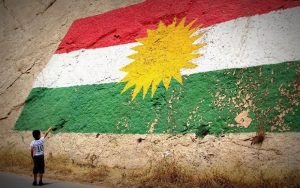Los Angeles is well-known for its major attractions such as Disneyland, Sea World, Universal Studios, and its many other attractions. Los Angeles is one of the most popular cities in the world. Of course, when people think of the city, they think of a very lavish lifestyle full of celebrities and famous Hollywood movies, but little do people know that there exists a whole different world in the southern part of the city. South-Central Los Angeles is known for its crime and gangs. The Bloods, which was a very big gang in Los Angeles, had already been formed and they were committing crimes throughout their neighborhoods in southern Los Angeles, much like their rival gang, the Crips. There was another gang known as the Barrio 18 (18th Street Gang), which was the largest gang not only in Los Angeles, but also in the country in the 1970s and 1980s. Though Los Angeles was the second largest Mexican population city in the world, it was also made up of numerous immigrant groups from Latin America beyond Mexico, and because of that, it was also the birthplace of the most dangerous and largest street gang in the world.
During the 1980s, the Central-American country of El Salvador was experiencing a very serious war between the government and its people. The army, loyal to the government, tried to recruit many young men to join with them, but many refused. With the war becoming more intense by the day, many people who were revolting against the government were being attacked. Since the government at the time was under a dictatorship, many of the young men were forced to join the government army. The recruiters would show up randomly at the schools. It did not matter if they were from high school, middle school, or elementary school, the government wanted young soldiers on their side. The recruiters took the young boys without giving warning to their families, and immediately trained them for war. Sometimes, when the army knew that some of these boys were against the government, they would simply kill them on the spot. Therefore, in fear of being drafted in this way, hundreds of thousands of Salvadorans fled to the United States.1 Most of the families who arrived in the United States had no idea where to go, because they did not have family members in the United States at that time. The immigrants spread throughout the southern United States, but the majority of the immigrants settled in various neighborhoods of Los Angeles. Within the city of Los Angeles, there were many longstanding gangs, such as Barrio 18, which mostly consisted of Mexican Americans, and there were also Asian gangs and African-American gangs. There was one particular neighborhood known as Pico Union, and it would become the birth place of one of the most notorious gangs of all time, based on the immigration of Salvadoran youths fleeing the violence of their homeland: MS-13.

The Pico Union neighborhood was originally home to a gang called the Barrio 18, or simply Street Gang 18. Before MS-13 came along, Barrio 18 was known as the most dangerous gang in America. At the time, Barrio 18 had a large number of members all over the United Sates, and some members resided in parts of Mexico or in Central America. Barrio 18 had become the most powerful gang in Los Angeles because of its violent acts and illegal business. Unlike MS-13, Barrio 18 was very well organized.2 Like any other gang, they were known for violence, illegal trading of narcotics, and prostitution, but they were constantly growing, especially since there were so many different groups of Latinos living in Los Angeles. But, all of that changed when the Salvadorans came into the picture.
Mexicans often harbor racist attitudes towards Salvadorans, and it was no surprise when tensions started rising between the two groups in the Pico Union district. There were many times when the two groups would start fights and would get in trouble with the authorities, which result in deportations, since many of the members were undocumented. Though most fights were physical, some of them resulted in many people getting seriously injured and sometimes killed. It was very common for many gangs to bring weapons with them for a fight, but since the Salvadorans were still ignorant to the ways of a gang, they were always unprotected.3
As time went by and the two gangs started to get into more conflicts, the need to fight back grew stronger among the Salvadorans. It is believed that the way MS-13 started came from a soccer match on the playground of Seoul International Park in the Pico-Union neighborhood of Los Angeles.4 Soccer is a very popular sport among Hispanics; therefore, it was not surprising to see the two groups play against each other. The Salvadorans and Mexicans were playing against each other when all of a sudden, a fight broke out that resulted in the Salvadorans being outnumbered once again. After that night, a group of young Salvadorans decided to get together and form what is now known as MS-13. The group swore to always protect their “barrio” or “hood.” From then on, MS-13 would expand to have around 700,000 members in many parts of the world.5

The gang started evolving and was soon starting to catch on to the gang lifestyle. Instead of guns, gang members would often carry a machete with them wherever they went. The machete was not only for protection, but it was also a way for the members to kill someone. The machete was also a common weapon for many Salvadorans to carry around with them back in El Salvador. One member of MS-13 would recall, “guarding the family’s crops at the age of 4, armed with a machete, alone at night.”6 Many times, their victims would suffer several cuts around their body or, in severe cases, some of their body parts would be completely cut off. As one officer recalled, he found a body, “on the banks of the Shenandoah River, repeatedly stabbed and her head nearly severed.”7
MS-13 consisted of many undocumented Salvadoran immigrants, but when the members started to get deported, they would go back to their country and spread the awareness of the newfound gang. Another distinct characteristic that the gang has is that the members of the gang usually have tattoos that use “the emblem MS-13” across their forehead, torso, or their back.8 Another common tattoo would be the devil’s hand with the MS-13 emblem. It was very easy to spot who the members of the gang were, let alone their mass number of members. The members of MS-13 would wear white shirts, maybe a flannel over it, large shorts that would often sag, and Cortez’s along with white socks. The gang adapted into a “cholo” like attire all while expanding their connections and creating a massive empire all throughout the 1980s. MS-13 grew more and they started having outposts all over El Salvador, Honduras, Nicaragua, and sometimes they would even recruit Mexicans. But, as the power and population increased, so did the tensions between them and Barrio 18.

As mentioned before, the Barrio 18 was mostly Mexican American, and Mexicans at that time were racist towards the Salvadorans. But, when MS-13 started growing and getting more dangerous, Barrio 18 could not help but notice what an empire the MS-13 had built. With both MS-13 controlling Pico-Union’s flourishing drug trafficking market, violence rose to a new level.9 A big reason why MS-13 became so famous was because of their distinct rivalry with Barrio 18. Since both groups had many members spread throughout the United States and many countries throughout Central America, they made many places very dangerous. For example, the city of San Pedro Sula in Honduras became one of the most dangerous countries in the world due to the gang violence between MS-13 and Barrio 18. Both gangs, “fight each other for control of territory so that they can expand their extortion rackets, trade in drugs and engage in other forms of organized crime. But gang members also murder their rivals simply to raise their status within their own gang, which helps perpetuate the conflict.”10
The way MS-13 operates is quite unique and is another aspect of what makes them unique. As one former member would say, “First is God, then your mother, then your gang. You live for God, you live for your mother, you die for your gang.”11 The gang seemed to be very family oriented, so they would recruit new members just as long as the new recruits would promise to stay loyal to them no matter what. If someone were to be discovered going behind the gang’s back or having relations with other gangs, then they would be killed without hesitation. For example, one member had turned to the government. Therefore, three MS-13 members—close friends of Paz— were “tapped” by the gang’s leadership to carry out her murder.12 MS-13 was very big on loyalty and being like a family, so there was no dictatorship that would keep the gang together, which also made them very difficult to take down by the authorities because they could not identify who the leader was. As many people would say, “It’s considered the fastest-growing, most violent and least understood of the nation’s street gangs.”13
Today, MS-13 has created a very large empire, spreading not only across the United States, but also throughout the world. The FBI has named MS-13 as the most dangerous gang and though there have been many efforts to stop their expansion, the gang seems to be almost impossible to stop.
- Kelly Padgett Lineberger, “Vanderbilt Journal of Transnational Law Note The United States – El Salvador Extradition Treaty: A Dated Obstacle in the Transnational War against Mara Salvatrucha (MS-13), ”Vanderbilt Journal of Transnational Law 44, no.1 (2011): 190-191. ↵
- Ana Arana, “How the Street Gangs Took Central America,” Foreign Affairs 84, no. 3 (2005): 102. Accessed February 28, 2020. doi:10.2307/20034353. ↵
- Arian Campo-Flores et al., “The Most Dangerous Gang in America,” Newsweek, 2005, 145 (13): 22–25. http://search.ebscohost.com/login.aspx?direct=true&db=a9h&AN=16479562&site=eds-live&scope=site. ↵
- Kelly Padgett Lineberger, “Vanderbilt Journal of Transnational Law Note The United States – El Salvador Extradition Treaty: A Dated Obstacle in the Transnational War against Mara Salvatrucha (MS-13).”Vanderbilt Journal of Transnational Law 44, no.1 (2011): 190-191. ↵
- Arian Campo-Flores et al., “The Most Dangerous Gang in America,” Newsweek, 2005, 145 (13): 22–25. http://search.ebscohost.com/login.aspx?direct=true&db=a9h&AN=16479562&site=eds-live&scope=site. ↵
- Arian Campo-Flores et al., “The Most Dangerous Gang in America,” Newsweek, 2005, 145 (13): 22–25. ↵
- Arian Campo-Flores et al., “The Most Dangerous Gang in America,” Newsweek, 2005, 145 (13): 22–25. ↵
- Charles Legge, “Tattoo That’s Sign of Terror,” Daily Mail, January 26, 2018. ↵
- Kelly Padgett Lineberger, “Vanderbilt Journal of Transnational Law Note The United States – El Salvador Extradition Treaty: A Dated Obstacle in the Transnational War against Mara Salvatrucha (MS-13),” Vanderbilt Journal of Transnational Law 44, no.1 (2011): 190-191. ↵
- Ioan Grillo, “The Kill Zone,” TIME Magazine, 2015, 186 (5): 42. ↵
- Kelly Padgett Lineberger, “Vanderbilt Journal of Transnational Law Note The United States – El Salvador Extradition Treaty: A Dated Obstacle in the Transnational War against Mara Salvatrucha (MS-13),” Vanderbilt Journal of Transnational Law 44, no.1 (2011): 190-191. ↵
- Kelly Padgett Lineberger, “Vanderbilt Journal of Transnational Law Note The United States – El Salvador Extradition Treaty: A Dated Obstacle in the Transnational War against Mara Salvatrucha (MS-13),” Vanderbilt Journal of Transnational Law 44, no.1 (2011): 190-191. ↵
- Arian Campo-Flores, et al., “The Most Dangerous Gang in America,” Newsweek, 2005, 145 (13): 22–25. ↵



75 comments
Jake Faryniarz
What is really surprising to me is how this gang functions and treats their members like family. That is probably one of the main reasons people join into their gang. I can see many people who grew up in poverty with little to no family to see this gang as a way to escape the hard times they have been through. To some, people probably see this gang as salvation by helping out giving people apart of the gang food and shelter. None the less this is an extremely dangerous organization that takes the lives of many and need to be stopped though it would be no easy task.
Lulu Guadalupe Avitua-Uviedo
Its scary to know that people are intrigued with joining a gang to have “family” or to feel superior by taking control of people by setting in fear or threats. I vacationed in Los Angeles for a month and I have a niece who lives there but like she says no matter what state you live in there are gangs, it’s just scary to know these gangs can take peoples lives away just by a look or association. This article gave great detail, I wish others could read it and learn from it.
Shriji Lalji
Very interesting article. Los Angeles seams like the dream city to be in but it comes with its flaws. Authorities should do what they can to limit gang violence however it is much easier said than done. In addition, immigration and border security also plays a big role in for the gangs in Los Angeles. It is crazy to think some people can be so violent.
Savannah Alcazar
I am not familiar with gang activity. I found the title of the article to be compelling while scrolling through crime related articles. The introduction is completely accurate, I think of celebrities when I think of Los Angeles California! Gang life had not crossed my mind in relation to that particular city. It is interesting to discover the background on how the gang was originated! A lot of good detail in this article.
Destiny Lucero
I really enjoyed this article. I spent some time deployed in El Salvador, and we had to be very careful there because the local gang did not want us Americans there. We had our own bus, and bus route from our hotel to our work place and it was common to see headless bodies on the side of the road as a warning to us. It was very scary, but as the military, we were secured and safe. It’s amazing to think of all this violence and gruesomeness all started from a soccer match with the Mexican gang. It’s kind of silly, but soccer is huge. Like in Barcelona and Milan, fights and violence break out all the time. I am curious about your connection to this topic and why you dedicated your article to it. Great read.
Nathaniel Bielawski
I hope that Los Angeles cracks down on the MS-13 gang. Their brutal attacks using machetes shows how dangerous they are to the public. Another thing that surprised me was their belief in God, yet they obviously ignore the ten commandments. I hope that the U.S. and other countries try to bring down the MS-13 empire and bring it’s members to justice.
Yazmin Garcia
I knew very little about gangs in general prior to reading this article. Let alone specifically this MS-13 gang. It is a shame to see how young men were taken away from their education in order to support a government that clearly wasn’t prioritizing their people’s interests. Having to leave your country and become estranged in one where they had no family to turn to must have been difficult. It almost seems like they had no choice but to become a part of this gang culture, which seems to be the case when recruiting young children into them.
Nelly Perez
Gangs are popular in movies and films, but there are some dangerous gangs in the world. MS-13 was a dangerous gang in Los Angeles. Around the south central side is where gang MS-13 lies. The neighborhood they lived in was the Pico Union neighborhood. Barrio 18 lived there before MS-13 came and they were considered the most powerful gang. Members were living in different places.
Berenice Alvarado
OMG this article is crazy. I knew that Los Angeles gangs have always been the most dangerous in the USA. Most movies that I watch that was related to any gang violence was based in LA. I like this article because it gives amazing background of how much the gang generated. I also find it extremely amazing how much people this gang actually had. This article was very interesting.
Matthew Avila
This article was very informative and was a great read! I always thought the MS-13 was a Mexican gang because that’s what everyone says in the media, but after reading this I now know their origins. when I was reading this, I was sympathizing with the Salvadorians because they just wanted to escape oppression. but when they ended up coming to LA, they were bullied by the Barro18 causing them to start of the notorious MS-13 initially for protection of one another. probably one of my favorite parts is when it says, “The gang seemed to be very family-oriented.” I just think its funny because its a gang they’re talking about.